The Magic of Abruzzo Blog
|
"We travel not to escape life but for life not to escape us." Anonymous
|
|
inWRITTEN BY OUR GUEST BLOG WRITER: MARIA LACIVITA Do you know what Abruzzo and Bavaria have in common? Abruzzo is sometimes called the "Bavaria of Italy" because of the large number of beautiful castles, fortresses and fortified cities that exist here in our area. Abruzzo boasts having over 700 castles in this small region of central Italy. If you have already been to Abruzzo, you may have seen a few of these beautiful and impressive buildings. For those who have not visited Abruzzo yet, I wanted to share a bit about these not to be missed castles. If you are a history, culture or nature lover, or if you simply enjoy walking and discovering new places ~ this article is for you. So, let's talk about some of these treasures of Abruzzo… To tell you about each castle and fortress I could write an entire manual, after all there are 700 of them! I have chosen a few to highlight in the Province of L'Aquila: some are well-known and others less known but still worth exploring. The Province of L’AQUILA 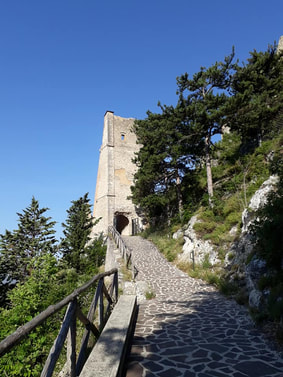 Roccacasale - Castello De Sanctis Where better to start than our own Roccacasale: as those of you who have visited already know, one of the most important symbols for the citizens of our village, and one of the most interesting tourist destinations, is the Castello De Sanctis. Documents indicate construction of the castle to be around 925 AD. Over time and in addition to weathering it became a ruin. It was also subject to invasions by several families. Sadly, it was partially destroyed in 1803 by the French. The municipality of Roccacasale started renovations to the castle in 1994. To date, the events hall has been completed, and most recently the stairs that will take you to its highest point. Although some parts of the castle are missing, it is a real gem. But most people come to Roccacasale to walk the steep incline up to the castle for the most amazing view you will ever see. These views from the castle are famous throughout the valley. In addition to spectacular views of the Peligna Valley, the castle hosts numerous events that animate the village, filling it with music, events and local news… especially in the summer months. 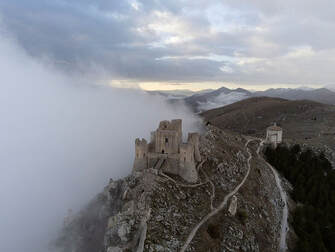 Calascio - Rocca Calascio One of the most famous castles in Abruzzo is the castle of Rocca Calascio. There are many reasons for its fame. Firstly, the tower at 1,520 meters high represents one of the highest castles in all of Italy. Secondly, it was one of the filming locations for the films LadyHawke, The Name of the Rose, and The Journey of the Bride and finally, this castle has also been included by National Geographic in the list of the 15 most beautiful castles in the world. Built in a strategic military position, this allowed sightings and communications with the surrounding areas. In fact, it is possible to observe the castle of Bominaco and vice versa. The castle of Rocca Calascio is a real gem of Abruzzo, which once seen, remains in the hearts of everyone who sees it. 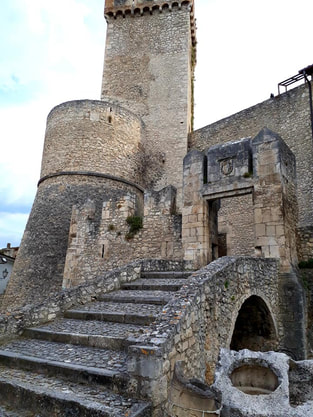 Capestrano - Castello Piccolomini The castle of Capestrano was built in the 12th century and is linked to the Dukes of Acquaviva from San Valentine, the Piccolomini and the Medici families. The old entrance to the castle (pictured) was found with a drawbridge allowing soldiers to cross the moat. The castle underwent restoration works in 1924. During restoration, the entrance was moved to the opposite side of the castle and included cutting a door and 5 windows in where now see the main entrance. You can walk around inside and climb the outer walls where you can see the spectacular view of the Tirino River Valley, hills and mountains. These days it is home to the local Commune which accounts for its immaculate condition. Many of the town’s annual festivals take place at or near the castle. You can even hire the castle for weddings or personal events. It is really worth walking around and taking in its history. There is no charge to walk around or even to view the small military ‘museum’ run by the locals. 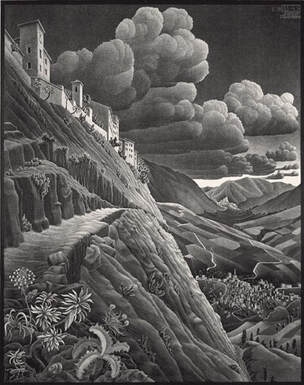 Castrovalva degli Abruzzi The province of L'Aquila is most likely the richest in castles and fortresses, some imposing with others smaller and hidden. In fact, the forth one I want to share with you is the fortified medieval village of Castrovalva. In the Valle del Sagittario, Castrovalva is located on a spur of rock just under 1000 meters high. The unspoiled nature that surrounds it still allows the free growth and movement of fauna, and animals including the Marsican bear of Abruzzo. What is interesting about this small village? It was the destination of many trips by the Dutch artist Maurits Cornelis Escher: he made many trips to Italy and Abruzzo discovering a region full of parks, uncontaminated villages, which at the time were also difficult to reach, around which the eye was lost between nature and vegetation. In these places the artist began to experiment with new forms of reality realization and he does it completely distorting the perspectives. From this period emerges one of his works which is part of the Escherian collection, the “Castrovalva” lithograph. Visit Abruzzo and experience these beautiful castles and medieval villages for yourself. Stay at
La Rocca Mia House B&B and let them escort you to your favorite castle! Email anytime: la.rocca.mia@outlook.com or call +39 388 8272982 Our Amazing 5-Day Holiday in Roccasale, Italy in Abruzzo Written by Shoshana Blauer Dear Diary, Though I have been to Italy several times before, this is the story of my first trip to Abruzzo - a region not well known in Italy. Last November, I had a conference to attend in Rome, and my husband and I decided to travel to some hidden places off of ‘the beaten track’. Well, did we ever find a gem! The B&B that we are staying at, La Rocca Mia House B&B, was recommended by three of my colleagues (thank you!!). The owners of the B&B arranged everything for us. They took care of every detail from breakfast to transportation to all the wonderful experiences we had. NOVEMBER 4th MONDAY Today, the start of our holiday in Abruzzo was an easy, and nothing short of spectacular, 2-hr bus ride due east of Rome to Roccacasale, which is in the Province of L'Aquila in the Abruzzo region of Italy. Built on the slopes of the Monte Morrone in the central Apennines, the village of Roccacasale overlooks the Peligna Valley and the town of Sulmona. Corfinio! What a sweet little village with their center piece the fountain adorned by hand crocheted squares made by the local women to honor those who died in the 2009 earthquake. We did so much just on our first day here! We are enjoying the beautiful crisp, clear fall weather. Domenico took us up the winding road to Scanno which is only about 45 minutes away. It is a picturesque town looking down to the valley below. We passed a beautiful lake so clear you could see the bottom, it was fun to see the original Roman bridge crossing over the pristine water.  Steve and I on the road to Scanno with the village of Anversa behind us and the pristine Lago San Domenico that we passed on our way to Scanno. Steve and I on the road to Scanno with the village of Anversa behind us and the pristine Lago San Domenico that we passed on our way to Scanno. Thankfully, Abruzzo is off the typical tourist trail (so far) and that’s what we like. Our Holiday in Abruzzo had No lines, no garbage, clean air, friendly and welcoming people… we were probably the only tourists. SO nice! Margaret and Domenico are wonderful hosts. Great first day! NOVEMBER 5th TUESDAY Cooking with Rosa. Another amazing day in Abruzzo! For me, the real way to know a region is through the food, the people, the beauty of the land.... that’s Abruzzo! First up, pizza rustica! The ingredients are eggs, flour, zucchini, cheese, olives, ham and yeast. It’s nothing like what you think of when you say pizza! Next up for cooking in Abruzzo - 'sugo' which means sauce and can include anything. In this case, it was zucchini, fresh mushrooms, and grated carrot. This is going to be served atop pasta- chittara! Chittara pasta - only in Abruzzo! The pasta is cut on a special device which is strung with tight wires (like a guitar) and after the dough I’d prepared, it’s rolled over the wires to cut the perfect pasta! What fun to do this. And finally, tiramisu. It is clearly is a classic dessert. It’s really not something I enjoy because I’m not a whipped-cream fan, but it was surprisingly fun to make! NOVEMBER 6th WEDNESDAY Was it the fact that it’s a market and I love markets? Was it the perfect combo of sun and clouds on this fall day? Was it the famous “confetti” that looks like flowers but is actually local almonds wrapped individually and turned into art? Was it the winding stone staircase? Was it just that it’s Sulmona on a Wednesday in Abruzzo?! Just WOW! After lunch we took off for Bominaco and Capistrano - today was full of sights and places in this gorgeous, beautiful and abundant valley. The church at Bominaco was built by monks, and the frescos have been preserved in this little town. The sad fact about all these precious villages is that they are all but deserted. No work for people so they all move to bigger cities or even the USA/Canada - leaving the elders to sit and watch the vacant streets as the seasons change. Thankfully, there is intermittent construction funded by local municipalities to shore up old buildings - when the money is gone, so are the people. On the way back to the B&B, Domenico stopped at another interesting village (cause that's what he does). I have to write the name of the little village so I won’t forget it...Pronounced, “Che-vi-tara-tenga” in the most beautiful valley in Abruzzo, originally a Jewish Ghetto in the 1400s. Nothing left of that and no descendants. This entire area was all agricultural in its heyday. The most important crop was saffron! Bulbs originally brought by monks - from Spain - who got it from the Arabs. This special variety of crocus has the saffron pistil that must be removed by hand! Once saffron was cultivated and sold “commercially” this industry in the valley all but dried up. NOVEMBER 7th THURSDAY Abbazia di Santo Spirito al Morrone in Badia. Monastery turned convent then prison and now museum. It houses the region’s cultural departments and we were treated with a thorough tour. After the abbazia, on what turned out to be THE most beautiful day, we had a hike planned for the Parco Nazionale della Majella. Describing this place would be like describing the Columbia Gorge. Big, bold, beautiful, expansive, unending vistas, fall colors, and more! Still the same day!! We visited the local frantoio where olive farmers bring their crop to be processed into the magic elixir. The color of the oil has no bearing on the quality or taste. It’s the acidity that has to be less than .02 for it to be considered extra virgin and the quality is determined by the time between picking and pressing. The quicker it’s pressed, the better quality (among other factors). This frantoio has been in the family for decades and the woman I’m sitting with is the wife of the original owner. To finish the day we had dinner at Il Carro Restaurant in Pratola. Trying Arrosticini for the first time. Little cubes of lamb roasted on a stick over coals and lightly salted after cooking. A local specialty and OH so yummy!!! NOVEMBER 8th FRIDAY This was our last day and Margaret and Domenico managed to squeeze in one more experience for us!! We hear about “truffle hunting” but until you’ve done it, you can’t imagine… three small dogs (Lagotto Romagnolo- which are the only ones approved by the Italian Kennel Club), joyfully run around in an oak tree grove - planted specifically for truffles which grow at their bases. When the dogs smell one (and they ARE pungent), they start to dig! Their trainer comes and takes his long handled spade and carefully unearths them so as not to break their lumpy bumpy black earth-crusted exterior. This holiday in Abruzzo, for me, was exactly what I was looking for...some place off the beaten track that gave us an authentic view of Italy from a rural point of view. See our review of the fabulous B&B that we stayed in and that arranged all these wonderful experiences for us. Then email Margaret and Domenico so that they can set up a similar trip for YOU! Just click here: la.rocca.mia@outlook.com for your next holiday in Abruzzo, Italy 5 stars ***** GUEST REVIEW
"A lesser-known region of Italy, (and we secretly hope it stays that way), is Abruzzo. La Rocca Mia B&B (Margaret and Domenico are the hosts), gives even the most well-traveled folks, experiences that demand return visits! The accommodations are ideal for a couple or family as the former church was transformed into a warm and inviting home base. Nestled at the base of La Rocca, short drives in every direction allow for guided activities such as hiking, truffle hunting, olive harvesting and pressing, and more. Cooking with the locals your thing? Rosa comes to you and spends several hours guiding you through the makings of an authentic Abruzzo meal. For each and every activity Margaret and Domenico have local contacts who are experts. This town is where Domenico grew up, and his knowledge and storytelling make all the secrets come alive. Two hours by bus from Rome and you have been transported into the idyllic part of Italy that commands you come back, again and again, to see and experience more! Thanks to La Rocca Mia- and the best hosts ever- we will be back!" Shoshana Blauer and Stephen Miller from Portland, Oregon Ours is such a unique region in Italy and in homage to this fact, Domenico has rounded up his favorite ‘Only in Abruzzo’ experiences. 1. Zip-Line through a huge gorge in the Majella National Park in full view of “one of the world's most beautiful villages in Italy - Pacentro”.
2. Explore nature and beautiful landscapes while hiking the wild canyons of Monte Morrone – the sacred mountain of the hermitage of Celestine V – the mountain enchanted by legends of fairies and witches. 3. Watch the sunset, feel the sea breeze and dine on a seafood feast in a traditional fisherman’s trabocchi on the Adriatic Sea. 4. Do sundowners in the Castel De Sanctis castle overlooking Roccacasale and the Peligna Valley. 5. Marvel at the Roman ruins in the town of Corfinio (the first capital of Italy) and browse its museum where you can see the first coin minted with the word Italia on it. 6. Dine at a traditional shepherd’s table – with true farm to table service. 7. Kayak or canoe on the crystal clear waters of the Tirino River then stop for a fresh grilled trout lunch. 8. Hunt for Truffles with the dogs as they joyfully run around in an oak tree grove sniffing for their precious treat. Guest testimonial: "Margaret emailed us beforehand to see what we were interested in, coming up with a suggested but flexible itinerary for everyone - much appreciated. We enjoyed intriguing castles, churches and unspoilt villages in the mountains, kayaking, paddle boating, swimming in the river/local pool, picnicking, festivals, winery, sugared almond factory, markets, relaxing and of course eating, drinking and talking - we quickly learnt that wherever we went, someone would stop and chat with Margaret or Domenico. But the highlight had to be meeting their family and friends and cooking with them (and my hubby getting down and dirty with an apron in the kitchen - a sight never before seen)." Lisa L. an Australian living in Qatar Email us to get started on an itinerary which includes these 'Only in Abruzzo' experiences that will prove to be a holiday of a lifetime! Click here: la.rocca.mia@outlook.com 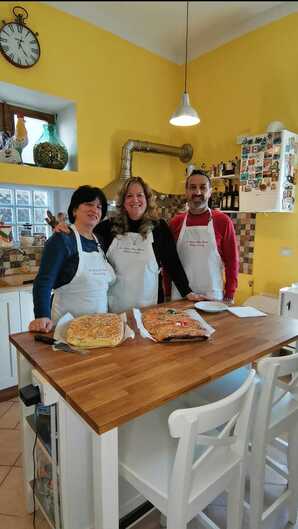 Easter is just around the corner. Spring is in the air! It is time to start thinking about baking that special Easter bread. There are many different types of Italian Easter Bread but most are made with the following ingredients: flour, oil, sugar, eggs, yeast and milk. Modern recipes are adding Pecorino, Parmigiano or another types of hard cheese. Watch the videos below and see how our neighbor Rosa makes this traditional Italian Easter treat. According to religious tradition, the Pizza di Pasqua should be prepared on Monday, Thursday or Good Friday to be eaten at breakfast on Easter Sunday. Once ready, it was customary to bring the Pizza di Pasqua to the church, so that it would be blessed together with the other foods to be consumed on Easter day, but this doesn’t happen much today. Though traditionally served at breakfast on Easter morning, it is also served as an appetizer during Easter lunch, it is accompanied by blessed boiled eggs, ciauscolo (a type of soft salami typically found in the region of Le Marche) and red wine. Pizza Di Pasqua di Abruzzo 1 kg flour 6 eggs plus one yolk 250 g milk 250 g sugar 250 g vegetable oil 2 cubes fresh yeast Zest of one lemon 1 tsp. vanilla Procedure: 1. Dissolve the yeast in tepid milk. 2. Add all the other ingredients. 3. Mix with a fork. 4. Work with the dough with your hands for 15-20 minutes on a floured surface. 5. Divide into two parts. 6. Using parchment paper in a shallow pan, place your dough onto the pan. 7. Brush on the egg yolk and add sprinkles and/or colored eggs. 8. Let rise for 3-4 hours. 9. Bake in the oven for 20-30 minutes at 180C. ENJOY!! BUONA PASQUA To watch a video of Rosa making this bread go to: Part 1: https://www.youtube.com/watch?v=g2_ouZtVPdg Part 2: https://www.youtube.com/watch?v=-0A2p5uN06o Part 3: https://youtu.be/oiefkrZ3V4I Visit us during the Easter season and we’ll invite Rosa over to teach you to bake this lovely Easter Bread. DON’T MISS OUT ON OUR EASTER EXPERIENCES: Just click on our Facebook cover photo “Experience Easter with Us” for all the details. Go to our FACEBOOK page here. In Italy, Christianity is found not only in the Churches, but in the basic fabric of everyday life. The architecture and art in every town, village and hamlet (no matter how big or small) is related to the Church. Most events are marked by religious recurrences, the majority of the fairs and festivals around the country are related to Christian saints. There are numerous religious sites in Abruzzo that remind us of Italy’s religious roots. #1 Hermitage of San Domenico, Villalago The Hermitage of San Domenico is located just outside the village of Villalago, on the Lake of San Domenico. According to tradition, in the 10th century, Saint Domenico dug the cave in which he lived as a hermit. Later, San Domenico’s retreat became a place of worship for many and a beautiful little church (chapel) was built as a tribute to him. At the rear of the church, is a door to a steep, narrow staircase that leads to the dark cavern where San Domenico once slept. #2 The Church of Santa Maria Assunta and the Oratory of San Pellegrino Located in the hamlet of Bominaco is one of Abruzzo's best-kept secrets. It includes two very different churches and the remains of a castle. All belonging to a powerful monastery which was the seat of power in this area from the 8th century through to its rebellion and destruction in the 1400s. The church of Santa Maria Assunta, with its Romanesque architecture and the important frescoes, sits on the hill above the small hamlet. What is most remarkable are the stone columns inside, each one decorated with a different crown. The smaller chapel, often called the ‘Sistine Chapel of Abruzzo', is painted with the most wonderfully dramatic frescoes depicting the life of Jesus, which cover the walls and ceiling (Childhood, the Passion, and the Final Judgment). Of particular interest are the frescoes that illustrate a monastic calendar on two opposite walls of the eastern part of the church. These special places of worship were a stopping point for those who followed the path of a sheep track that passes through the area. #3 The Hermitage of Sant'Onofrio al Morrone The Hermitage of Sant'Onofrio al Morrone is a religious building that has been a national monument since 1902. It is located on the slopes of the Morrone Mountain, near Sulmona dating back to the thirteenth century. It houses the memory of Pietro Angelerio (or Pietro da Morrone ), the hermit friar who lived there and who became pope in 1294 with the name of Celestino V – he later became a saint . The hermitage can be reached by a steep path. It is an easy to walk, and leads from the hamlet of Badia to the eastern edge of the Peligna Valley up to the altitude of 620 meters. Below this church there is an old Roman temple. The local villagers of the valley go here the day after Easter. They walk from Pratola all the way up to the hermitage to pray and then to have a picnic. #4 Santuario del Volto Santo The small town of Manoppello has recently come to fame as the home of the reported Veil of Veronica. Somewhat forgotten over the centuries, this is the cloth reportedly given to Jesus to wipe his face as he carried his cross to Calvary. Although it is not specifically mentioned in the Bible, it was a widespread belief that it existed. In the basilica, behind the alter, you will find the image of the Holy Face (Volto Santo). It is similar to the more famous Shroud of Turin. The image that appears is not painted on the surface, but is part of the cloth itself. You are able to walk up to the framed Volto Santo which is surrounded by glass. #5 The Abbey of Santo Spirito al Morrone
The Abbey of Santo Spirito al Morrone is the most important and famous settlement of the Congregation of the Celestines as well as the center of cultural, religious and civil life. This monumental complex, which occupies an area of 16,600 square meters, is located just 5 km from the center of Sulmona in Badia. Its origins are linked to Pietro di Angelerio, Benedictine monk, and hermit, who was also founder of the Celestini order and Pope with the name of Celestino V. This complex has been used for numerous purposes since it was founded, one of which was a prison. Feast of Madonna della Libera Every year in the month of May, an exciting religious event that takes place in Domenico’s hometown of Pratola Peligna called the Feast of Madonna Della Libera. We invite you to join us for the Feast of Madonna Della Libera. This is a two-week-long event that starts with the novena (9 days of solemn prayers) and finishes with a celebration that the entire village takes part in. The program is divided between religious and civil events. There are many processions through the streets along with the local band and the village priest. On the non-religious side there are DJ’s and special concerts in the evenings with dancing and singing in the streets. There are also special activities for children and a huge fireworks display. On Friday, the pilgrims (young and old) begin a historic journey from Gioia Dei Marsi and walk for about 14 hours until they reach the village of Pratola. All of the village awaits the pilgrims’ arrival. The people wait at the entrance to the village (the priest, the people, and the band) walk with them to the church. As the pilgrims arrive, they sing the song of the Madonna Della Libera. The pilgrims proceed onto their knees for the last 50 meters to the church alter where they kiss the painting of the Madonna. The pilgrims stay for the weekend to celebrate with the town and then return to Gioia Dei Marsi on Sunday. These are just a few of the many celebrations that tie religion to everyday life in our beautiful region of Abruzzo… come visit us and experience some or all for yourself! |
About the authorThis blog is curated by Margaret Gigliotti, B&B owner, teacher, explorer, wine drinker and creative writer. Looking for ideas of places to visit in Abruzzo. Download our free guide of the best places most people miss.
Categories |
Check us out on: |
Find out more about our latest news and offers by receiving our free monthly publication.
Just click on this photo. |
email us at: la.rocca.mia@outlook.com
website: www.laroccamiahouse.com Telephone: +39 3888 272982 |